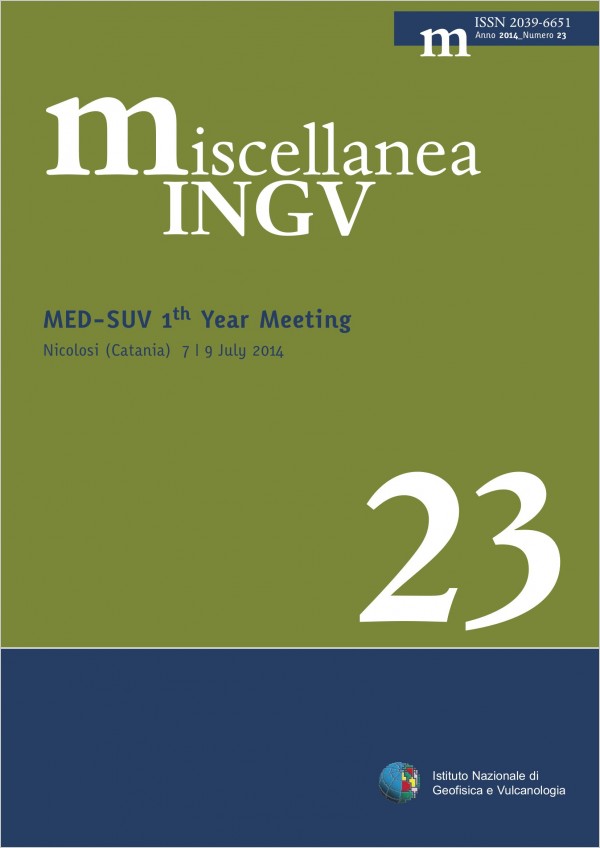The MED-SUV project is a response to the European Community call “ENV.2012.6.4-2 - Long-term monitoring experiments in geologically active regions of Europe prone to natural hazards: the Supersite concept - FP7-ENV-2012-two-stage – of 20 July 2011.
Among the requests, the call stated that the accepted projects had to contribute to the Geohazards Supersites and Natural Laboratories (GSNL) initiative. The GSNL is an ambitious initiative, which is based on the “Frascati declaration” stated at the conclusion of the “3rd International Geohazards Workshop” of GEO held in ESA-ESRIN in November 2007. The declaration recommended “…to stimulate an international and intergovernmental effort to monitor and study selected reference sites by establishing open access to relevant datasets according to GEO principles to foster the collaboration between all various partners and endusers…”.
After a first period based on a volunteer approach, during which seven initial Supersites were identified, including Mt. Etna and Campi Flegrei/Vesuvius, the Supersites initiative was developed in the framework of the GEO-GEOSS Work Plan.
The MED-SUV project aims to apply the Supersite concept to Mt. Etna and Campi Flegreii/Vesuvius, recently recognized as Permanent Supersites by the Scientific Advisory Committee of GSNL and the Supersites Coordination Team of the Committee on Earth Observing Satellites. These two active volcanic areas represent end-members of volcanic systems, Mt. Etna being an open-conduit volcano and Vesuvius and Campi Flegreii closed-conduit systems. Given their differences, and that the two volcanic areas lie in densely populated areas, these two Supersite volcanoes pose diverse volcanic hazards at local, regional, and continental scales.
In order to improve understanding of the volcanic processes of Mt. Etna and Campi Flegrei/Vesuvius, and thus improve hazard assessment, the MED-SUV project will use the large sets of data available for both sites. Integration of both ground and EO data, collected over long time periods, will enable the volcanology community to answer key questions relating to prediction of the occurrence, location, duration, and magnitude of eruptive events. Additional achievements will include (1) optimization of the link between observations and end-users during eruptive events, and (2) evaluation of the project outcomes to assess whether they provide enforceable prototypes for the next generation of fully integrated volcano-monitoringand research systems, and whether they are applicable to other volcanic areas.
Last but not least, a crucial mandate emerging from the Supersites rationale is the need to guarantee the sharing of data and scientific products for the promotion of unselfish scientific collaboration. The MED-SUV consortium comprises 24 partners from 9 countries, including two from outside Europe (the USA and Canada). The consortium includes both scientific and industrial partners as well as public agencies with long experience covering all volcanic risk management practice from making observations to public communication.
To accomplish the objectives, the MED-SUV Project is structured in six Work Packages for research and technology implementation (WP2-7), and two Work Packages devoted to project management (WP1) and information dissemination (WP8). WP2 and WP3 implement the next generation of observing systems. Their activity embraces the development of new systems (WP2) and full exploitation of existing ones (WP3). This includes the design and development of an e-infrastructure for sharing data and products. WP4 and WP5 focus on characterization and modelling of volcanic processes at the two Supersites. Hazard assessment and fostering relationships between scientists and end users are the aims of WP6. WP7 will test the main outcomes of the other WPs, and implement a pilot phase at the two supersites and in two selected test cases– Piton de la Fournaise and the Azores.
The MED-SUV project started in June 2013. One year later, the kick-off meeting was held in Naples. We now convene again to present and discuss our ongoing activities and first outcomes, to revisit our future plans, and to strengthen the cooperation between participants. The 1st Year Meeting is hosted in Nicolosi village, a popular place in the European volcanology community because of its history as the base for many teams working at Mt. Etna. It is considered to be the “door” to Mt. Etna. Nicolosi was the birthplace of the brothers Carlo and Mario Gemmellaro, who were born in the 18th century. They began the modern volcanology studies of Mt. Etna that we continue, in the MED-SUV project, at the present day.
Published: 2024-02-09

